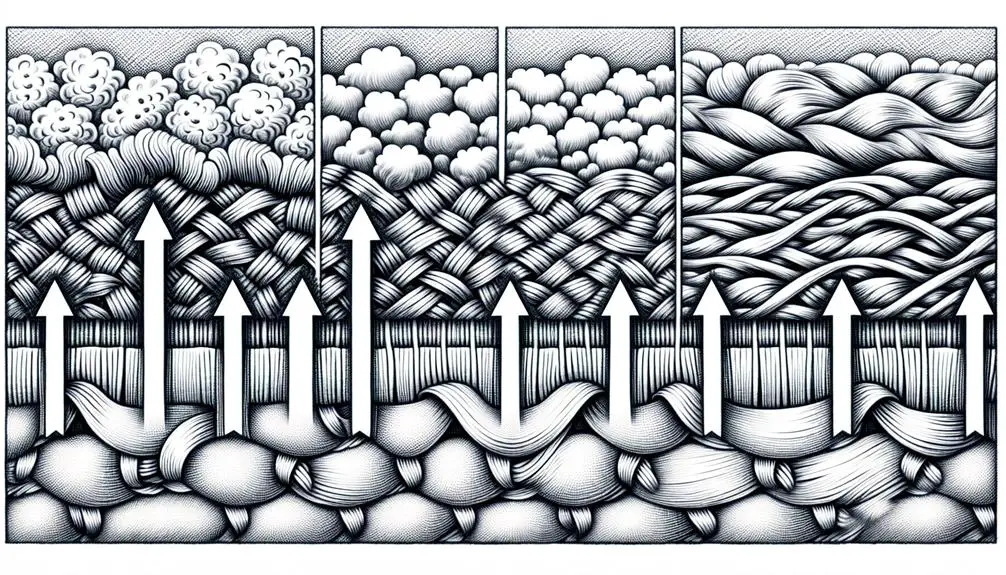You might not realize that fabric breathability isn't just about how much air flows through your clothes; it's also about how well the fabric manages moisture and heat. This interplay determines your overall comfort, especially during physical activities or in varying climates. By understanding the underlying science, you can make smarter choices about what to wear for different conditions. Ever wonder why some fabrics leave you feeling sticky while others keep you cool and dry? Let's explore the intricate factors that affect breathability and discover how to choose the best material for your needs.
Table of Contents
Key Takeaways
- Fabric breathability involves air and moisture permeability, impacting comfort and microclimate maintenance.
- Natural fabrics like cotton and linen generally provide better breathability than synthetic fabrics.
- Weave openness and fabric structure significantly influence breathability levels.
- Measurement techniques like WVTR, MVTR, and the Sweating Hot Plate Test assess a fabric's breathability.
- Effective fabric selection depends on intended use, balancing air circulation, moisture management, and heat retention.
Understanding Fabric Breathability
Understanding fabric breathability starts with recognizing how effectively a material allows air and moisture to pass through.
A breathable fabric efficiently handles moisture, ensuring that sweat evaporates rather than sticking to your skin. This moisture control is crucial for maintaining a cozy microclimate around your body.
When a fabric has high air permeability, it permits air to circulate freely, which helps in cooling you down and reducing any sticky feeling.
You'll also want to contemplate heat retention. Breathable fabrics strike a balance between releasing excess heat and keeping you warm enough, which directly affects your overall comfort level.
If a fabric retains too much heat, you could feel overheated and uncomfortable. On the other hand, if it releases too much heat, you might feel cold.
Mastering fabric breathability involves understanding these dynamics. By focusing on how effectively a fabric manages moisture and allows air to circulate, you can make informed choices that enhance your comfort in various conditions.
Whether you're selecting activewear, outdoor gear, or everyday clothing, these principles guarantee you stay comfortable and dry, regardless of the environment.
Key Factors Affecting Breathability
When selecting fabrics for breathability, several key elements come into play that directly impact how comfortable you'll feel.
First and foremost, moisture management is essential. A fabric that wicks moisture away from your skin keeps you dry and greatly enhances comfort. Effective moisture management reduces the clammy feeling that often accompanies sweat build-up.
Heat dissipation is another vital factor. Fabrics that facilitate heat dissipation help you stay cool, especially during intense physical activities. This is typically achieved through materials that allow heat to escape rather than trapping it against your body.
Air circulation within the fabric structure is also crucial. Fabrics designed with a more open weave permit better air flow, which aids in both moisture management and heat dissipation. You'll find that materials like mesh or those with perforations enable superior air circulation, making them ideal for high-performance wear.
Lastly, the fabric structure itself can't be ignored. The way fibers are woven or knitted together affects how well the fabric breathes. Dense weaves might offer durability but can limit breathability, while looser structures enhance it.
Understanding these factors will empower you to make informed choices for maximum comfort.
Natural Vs. Synthetic Fabrics
Comparing natural and synthetic fabrics reveals distinct differences in breathability that can greatly impact your comfort. Natural fabrics like cotton and linen are celebrated for their exceptional breathability. Cotton, for example, allows air to circulate freely, wicking moisture away from your skin and keeping you cool. Linen, with its loosely woven fibers, excels in hot climates by promoting airflow and quick drying. These characteristics make natural fabrics ideal for those who prioritize comfort and breathability.
On the other hand, synthetic fabrics like polyester and nylon have different attributes. Polyester is known for its durability and moisture-wicking properties but often lacks the same level of breathability as cotton. It can trap heat, leading to discomfort in warmer conditions. Nylon, while lightweight and quick-drying, also tends to restrict airflow more than linen, potentially causing you to feel warmer.
Understanding these distinctions helps you make informed decisions when selecting fabrics. Opting for natural materials like cotton and linen can enhance breathability, especially in hot and humid environments.
Conversely, synthetic options like polyester and nylon may be better suited for activities requiring durability and moisture management, albeit with some trade-offs in breathability.
Measuring Breathability
To measure fabric breathability, you can use a variety of standardized tests that assess how well air and moisture pass through the material. Understanding these testing methods is vital for those aiming to master the nuances of fabric performance. Here are the key methods you should focus on:
- Water Vapor Transmission Rate (WVTR): This test measures how much water vapor passes through the fabric over a specific time period. A higher WVTR indicates better breathability.
- Moisture Vapor Transmission Rate (MVTR): Similar to WVTR, MVTR evaluates the fabric's ability to allow moisture to escape, providing a breathability rating that's essential for activewear.
- Sweating Hot Plate Test: This method simulates human sweating and measures the fabric's ability to transfer moisture and heat away from the body. It gives a detailed breathability rating under controlled conditions.
- Air Permeability Test: This test measures the rate at which air passes through the fabric. Higher air permeability often denotes better breathability, ideal for everyday wear.
Choosing the Right Fabric
Selecting the right fabric is essential for ensuring comfort, performance, and durability in your garments. To fully harness the breathability benefits, you need to understand the properties of different materials.
Breathability is the fabric's ability to allow moisture vapor to pass through, which keeps you dry and comfortable. Your fabric selection should align with the intended use of the garment, whether it's for athletic wear, casual clothing, or professional attire.
Cotton is a popular choice for its natural breathability, making it ideal for everyday wear. However, for athletic pursuits, you might opt for synthetic fabrics like polyester or nylon, which provide moisture-wicking capabilities alongside breathability. Merino wool is another excellent option, offering both breathability and thermal regulation, perfect for outdoor activities in various climates.
When considering fabric selection, pay attention to the weave and weight of the material. Loosely woven fabrics typically offer better breathability than tightly woven ones. Additionally, lightweight fabrics usually enhance airflow, while heavier fabrics might restrict it.
Frequently Asked Questions
How Does Fabric Breathability Impact Athletic Performance?
Fabric breathability directly impacts your athletic performance by enhancing sweat management and heat regulation. When you stay cool and dry, your comfort improves, allowing you to focus better and push your limits more effectively.
Are Breathable Fabrics Suitable for Winter Clothing?
Breathable fabrics can be suitable for winter clothing if they're paired with proper winter insulation. You'll experience enhanced cold weather comfort by maintaining dryness, preventing sweat buildup, and allowing moisture to escape efficiently.
Can Fabric Breathability Affect Allergy Sufferers?
Imagine breathing freely again. Yes, fabric breathability can impact allergy sensitivity. By choosing breathable textiles, you improve respiratory health, reducing allergens trapped in your clothing. Embrace breathable fabrics to alleviate discomfort and enhance your well-being.
How Does Fabric Breathability Influence Moisture-Wicking Properties?
Fabric breathability directly influences moisture-wicking properties by enhancing sweat management. When fabrics breathe well, they efficiently move moisture away from your skin, greatly improving your comfort level during physical activities or in hot climates.
What Advancements Are Being Made in Breathable Fabric Technology?
You're seeing advancements in breathable fabric technology through sustainable options and innovative materials. These include eco-friendly fibers and advanced synthetic blends that regulate temperature and enhance moisture control, revolutionizing comfort and performance in apparel.
- Metal Fabrication Companies in China: An Outsourcing Guide - June 20, 2025
- The Process of Custom Fabric Printing in China Explained - June 20, 2025
- Understanding the Characteristics of China Silk Lining Fabric - June 20, 2025




